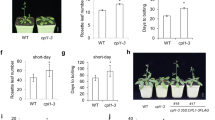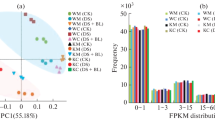Abstract
CO2 levels are known to have an impact on plant development and physiology. In the current study, we have investigated the effect of elevated CO2 on flowering and its regulation through miRNA mediated sugar signaling. We also unraveled small RNA transcriptome of pigeonpea under ambient and elevated CO2 conditions and predicted the targets for crucial miRNAs through computational methods. The results have shown that the delayed flowering in pigeonpea under elevated CO2 was due to an imbalance in C:N stoichiometry and differential expression pattern of aging pathway genes, including SQUAMOSA PROMOTER BINDING PROTEIN-LIKE. Furthermore, qRT PCR analysis has revealed the role of miR156 and miR172 in mediating trehalose-6-phosphate dependent flowering regulation. The current study is crucial in understanding the responses of flowering patterns in a legume crop to elevated CO2 which showed a significant impact on its final yields. Also, these findings are crucial in devising effective crop improvement strategies for developing climate resilient crops, including pigeonpea.






Similar content being viewed by others
Data availability
The small RNA transcriptome of Cajanus cajan has been submitted to NCBI Sequence Read Archive and BioSample databases with accession numbers PRJNA311633 and SAMN04487131. The project ID is SRP069891.
References
Ainsworth EA, Long SP (2021) 30 years of free-air carbon dioxide enrichment (FACE): what have we learned about future crop productivity and its potential for adaptation? Glob Change Biol 27:27–49. https://doi.org/10.1111/gcb.15375
Carrington JC, Ambros V (2003) Role of MicroRNAs in plant and animal development. Science. https://doi.org/10.1126/science.1085242
Chen X (2005) MicroRNA biogenesis and function in plants. FEBS Lett 579:5923–5931. https://doi.org/10.1016/j.febslet.2005.07.071
Chen L, Ren Y, Zhang Y, Xu J, Zhang Z, Wang Y (2012) Genome-wide profiling of novel and conserved Populus microRNAs involved in pathogen stress response by deep sequencing. Planta 235:873–883. https://doi.org/10.1007/s00425-011-1548-z
Chen D, Yan W, Fu LY, Kaufmann K (2018) Architecture of gene regulatory networks controlling flower development in Arabidopsis thaliana. Nat Commun 9:4534. https://doi.org/10.1038/s41467-018-06772-3
Cho LH, Yoon J, An G (2017) The control of flowering time by environmental factors. Plant J 90:708–719. https://doi.org/10.1111/tpj.13461
Cuperus JT, Fahlgren N, Carrington JC (2011) Evolution and functional diversification of MIRNA genes. Plant Cell 23(2):431–442. https://doi.org/10.1105/tpc.110.082784
Dai X, Zhuang Z, Zhao PX (2018) PsRNATarget: a plant small RNA target analysis server (2017 release). Nucleic Acids Res 46(W1):W49–W54. https://doi.org/10.1093/nar/gky316
Das A, Mondol T (2010) Computational identification of conserved microRNAs and their targets in tea (Camellia sinensis). Am J Plant Sci 1:77–86. https://doi.org/10.4236/ajps.2010.12010
Fornara F, de Montaigu A, Coupland G (2010) SnapShot: control of flowering in Arabidopsis. Cell 141:550. https://doi.org/10.1016/j.cell.2010.04.024
Giannoccaro E, Wang YJ, Chen P (2006) Effects of solvent, temperature, time, solvent to sample ratio, sample size, and defatting on the extraction of soluble sugars in soybean. J Food Sci 71:59–64. https://doi.org/10.1111/j.1365-2621.2006.tb12389.x
Heyer AG, Raap M, Schroeer B, Marty B, Willmitzer L (2004) Cell wall invertase expression at the apical meristem alters floral, architectural, and reproductive traits in Arabidopsis thaliana. Plant J 39:161–169. https://doi.org/10.1111/j.1365-313X.2004.02124.x
Hong Y, Jackson S (2015) Floral induction and flower formation—the role and potential applications of miRNAs. Plant Biotechnol J 13:282–292. https://doi.org/10.1111/pbi.12340
Hou X, Zhou J, Liu C, Liu L, Shen L, Yu H (2014) Nuclear factor Y-mediated H3K27me3 demethylation of the SOC1 locus orchestrates flowering responses of Arabidopsis. Nat Commun 5:1–14. https://doi.org/10.1038/ncomms5601
Huijser P, Schmid M (2011) The control of developmental phase transitions in plants. Development 138:4117–4129. https://doi.org/10.1242/dev.063511
Hyun Y, Richter R, Vincent C, Martinez-Gallegos R, Porri A, Coupland G (2016) Multi-layered regulation of SPL15 and cooperation with SOC1 integrate endogenous flowering pathways at the Arabidopsis shoot meristem. Develop Cell 37:254–266. https://doi.org/10.1016/j.devcel.2016.04.001
Irish V (2017) The ABC model of floral development. Curr Biol 27:R853–R909. https://doi.org/10.1016/j.cub.2017.03.045
Jack T (2004) Molecular and genetic mechanisms of floral control. Plant Cell 16:S1–S17. https://doi.org/10.1105/tpc.017038
Jian X, Zhang L, Li G et al (2010) Identification of novel stress-regulated microRNAs from Oryza sativa L. Genomics 95:47–55. https://doi.org/10.1016/j.ygeno.2009.08.017
Jung JH, Seo PJ, Kang SK, Park CM (2011) MiR172 Signals are incorporated into the MiR156 signaling pathway at the SPL3/4/5 genes in Arabidopsis developmental transitions. Plant Mol Biol 76:35–45. https://doi.org/10.1007/s11103-011-9759-z
Khan MRG, Ai XY, Zhang JZ (2014) Genetic regulation of flowering time in annual and perennial plants. Wiley Interdiscip Rev 5(3):347–359. https://doi.org/10.1002/wrna.1215
Kumar S, Sreeharsha RV, Mudalkar S, Sarashetti PM, Reddy AR (2017) Molecular insights into photosynthesis and carbohydrate metabolism in Jatropha curcas grown under elevated CO2 using transcriptome sequencing and assembly. Sci Rep 7(1):11066
Lin YL, Tsay YF (2017) Influence of differing nitrate and nitrogen availability on flowering control in Arabidopsis. J Exp Bot 68:2603–2609. https://doi.org/10.1093/jxb/erx053
Livak KJ, Schmittgen TD (2001) Analysis of relative gene expression data using real-time quantitative PCR and the 2-∆∆CT method. Methods 25:402–408. https://doi.org/10.1006/meth.2001.1262
Lu J, Getz G, Miska EA et al (2005) MicroRNA expression profiles classify human cancers. Nature 435:834–838
Lu C, Meyers BC, Green PJ (2007) Construction of small RNA cDNA libraries for deep sequencing. Methods 43:110–117. https://doi.org/10.1016/j.ymeth.2007.05.002
Lu S, Sun YH, Chiang VL (2008) Stress-responsive microRNAs in Populus. Plant J 55:131–151. https://doi.org/10.1111/j.1365-313X.2008.03497.x
May P, Liao W, Wu Y et al (2013) The effects of carbon dioxide and temperature on microRNA expression in Arabidopsis development. Nat Commun 4:2145. https://doi.org/10.1038/ncomms3145
Meyer F, Paarmann D, D'Souza M, Olson R, Glass EM, Kubal M et al (2008) The metagenomics RAST server–a public resource for the automatic phylogenetic and functional analysis of metagenomes. BMC Bioinform 9:1–8. https://doi.org/10.1186/1471-2105-9-386
Moghaddam MRB, Ende WVD (2013) Sugars, the clock and transition to flowering. Front Plant Sci 4:22. https://doi.org/10.3389/fpls.2013.00022
Mudalkar S, Sreeharsha RV, Reddy AR (2016) A novel aldo-keto reductase from Jatropha curcas L. (JcAKR) plays a crucial role in the detoxification of methylglyoxal, a potent electrophile. J Plant Physiol 195:39–49
O’Hara LE, Paul M, Wingler A (2013) How do sugars regulate plant growth and development? new insight into the role of trehalose-6-phosphate. Mol Plant 6:261–274. https://doi.org/10.1093/mp/sss120
Paul S, Kundu A, Pal A (2014) Identification and expression profiling of Vigna mungo microRNAs from leaf small RNA transcriptome by deep sequencing. J Integr Plant Biol 56:15–23. https://doi.org/10.1111/jipb.12115
Ponnu J, Schlereth A, Zacharaki V, Działo MA, Abel C, Feil R, Schmid M, Wahl V (2020) The trehalose 6-phosphate pathway impacts vegetative phase change in Arabidopsis thaliana. Plant J 104(3):768–780. https://doi.org/10.1111/tpj.14965
Quiroz S, Yustis JC, Chávez-Hernández EC, Martínez T et al (2021) Beyond the genetic pathways, flowering regulation complexity in Arabidopsis thaliana. Int J Mol Sci 22:5716. https://doi.org/10.3390/ijms22115716
Rogers A, Ainsworth EA, Leakey ADB (2009) Will elevated carbon dioxide concentration amplify the benefits of nitrogen fixation in legumes? Plant Physiol 151:1009–1016. https://doi.org/10.1104/pp.109.144113
Sanz-Saez A, Perez-Lopez U, del Canto A, Ortiz-Barredo A et al (2019) Changes in environmental CO2 concentration can modify Rhizobium-soybean specificity and condition plant fitness and productivity. Environ Exp 162:133–143. https://doi.org/10.1016/j.envexpbot.2019.01.013
Sawa M, Nusinow DA, Kay SA, Imaizumi T (2007) FKF1 and GIGANTEA complex formation is required for day-length measurement in Arabidopsis. Science 318:261–265
Sekhar KM, Sreeharsha RV, Reddy AR (2015) Differential responses in photosynthesis, growth and biomass yields in two mulberry genotypes grown under elevated CO2 atmosphere. J Photochem Photobiol B 151:172–179
Simpson GG, Dean C (2002) Arabidopsis, the rosetta stone of flowering time? Science 296:285–289. https://doi.org/10.1126/science.296.5566.285
Springer JC, Orozco RA, Kelly JK, Ward JK (2008) Elevated CO2 influences the expression of floral-initiation genes in Arabidopsis thaliana. New Phytol 178:63–67. https://doi.org/10.1111/j.1469-8137.2008.02387.x
Sreeharsha RV, Sekhar KM, Reddy AR (2015) Delayed flowering is associated with lack of photosynthetic acclimation in pigeonpea (Cajanus cajan L.) grown under elevated CO2. Plant Sci 231:82–93. https://doi.org/10.1016/j.plantsci.2014.11.012
Sreeharsha RV, Mudalkar S, Unnikrishnan DK, Venkata Mohan S, Reddy AR (2021) Improving nitrogen use efficiency of legumes under changing climate through omics technologies. In: Kumar A, Kumar R, Shukla P, Pandey MK (eds) Omics technologies for sustainable agriculture and global food security. Springer Singapore, Singapore, pp 149–168
Subramanian S, Fu Y, Sunkar R, Barbazuk WB, Zhu J, Yu O (2008) Novel and nodulation-regulated microRNAs in soybean roots. BMC Genom 9:160. https://doi.org/10.1186/1471-2164-9-160
Sunkar R, Kapoor A, Zhu JK (2006) Posttranscriptional induction of two Cu/Zn superoxide dismutase genes in Arabidopsis is mediated by downregulation of miR398 and important for oxidative stress tolerance. Plant Cell 18:2051–2065. https://doi.org/10.1105/tpc.106.041673
Taub DR, Miller B, Allen H (2008) Effects of elevated CO2 on the protein concentration of food crops: a meta-analysis. Glob Change Bio 14:565–575. https://doi.org/10.1111/j.1365-2486.2007.01511.x
Unnikrishnan DK, Sreeharsha RV, Reddy AR (2021) Growth, seed yield and nutritional characteristics of pigeonpea grown under elevated CO2 atmosphere. Acta Physiol Plant. https://doi.org/10.1007/s11738-021-03245-x
Vazquez F, Legrand S, Windels D (2010) The biosynthetic pathways and biological scopes of plant small RNAs. Trends Plant Sci 15:337–345. https://doi.org/10.1016/j.tplants.2010.04.001
Wahl V, Ponnu J, Schlereth A et al (2013) Regulation of flowering by trehalose-6-phosphate signaling in Arabidopsis thaliana. Science 339:704–707. https://doi.org/10.1126/science.1230406
Wang JW, Czech B, Weigel D (2009) miR156-regulated SPL transcription factors define an endogenous flowering pathway in Arabidopsis thaliana. Cell 138:738–749. https://doi.org/10.1016/j.cell.2009.06.014
Wang M, Zang L, Jiao F et al (2020) Sugar signaling and post-transcriptional regulation in plants: an overlooked or an emerging Topic? Front Plant Sci 11:578096. https://doi.org/10.3389/fpls.2020.578096
Weber K, Burow M (2018) Nitrogen—essential macronutrient and signal controlling flowering time. Physiol Plant 162:251–260. https://doi.org/10.1111/ppl.12664
Wong CE, Zhao YT, Wang XJ et al (2011) MicroRNAs in the shoot apical meristem of soybean. J Exp Bot 62(8):2495–2506. https://doi.org/10.1093/jxb/erq437
Wu G, Park MY, Conway SR, Wang JW, Weigel D, Poethig RS (2009) The sequential action of MiR156 and MiR172 regulates developmental timing in Arabidopsis. Cell 138:750–759. https://doi.org/10.1016/j.cell.2009.06.031
Yamaguchi A, Wu MF, Yang L, Wu G, Poethig RS, Wagner D (2009) The microRNA-regulated SBP-box transcription factor SPL3 Is a direct upstream activator of LEAFY, FRUITFULL, and APETALA1. Dev Cell 17:268–278. https://doi.org/10.1016/j.devcel.2009.06.007
Yang L, Xu M, Koo Y, He J, Poethig RS (2013) Sugar promotes vegetative phase change in Arabidopsis thaliana by repressing the expression of MIR156A and MIR156C. eLife 2:e00260. https://doi.org/10.7554/eLife.00260
Yu S, Cao L, Zhou CM et al (2013) Sugar is an endogenous cue for juvenile-to-adult phase transition in plants. eLife 2:e00269. https://doi.org/10.7554/eLife.00269
Zhang B, Pan X, Cannon CH, Cobb GP, Anderson TA (2006) Conservation and divergence of plant microRNA genes. Plant J 46:243–259. https://doi.org/10.1111/j.1365-313X.2006.02697.x
Zuker M (2003) Mfold web server for nucleic acid folding and hybridization prediction. Nucleic Acids Res 31:3406–3415. https://doi.org/10.1093/nar/gkg595
Funding
The work was funded by DBT grant (BT/PR-12024/BCE/8/1097/2014) from Department of Biotechnology, Government of India. We greatly acknowledge ICRISAT, Patancheru, India for providing pigenopea germplasm. RVS acknowledges INSPIRE Faculty grant (DST/INSPIRE/04/2018/000214) from DST, New Delhi.
Author information
Authors and Affiliations
Contributions
DKU, RVS, SM and ARR designed experiments. DKU, RVS and SM performed experiments. DKU, RVS, SM and ARR analysed data, discussed results and wrote manuscript.
Corresponding author
Ethics declarations
Conflict of interest
The authors have no relevant financial or non-financial interests to disclose.
Additional information
Publisher's Note
Springer Nature remains neutral with regard to jurisdictional claims in published maps and institutional affiliations.
Supplementary Information
Below is the link to the electronic supplementary material.
Rights and permissions
Springer Nature or its licensor (e.g. a society or other partner) holds exclusive rights to this article under a publishing agreement with the author(s) or other rightsholder(s); author self-archiving of the accepted manuscript version of this article is solely governed by the terms of such publishing agreement and applicable law.
About this article
Cite this article
Unnikrishnan, D.K., Sreeharsha, R.V., Mudalkar, S. et al. Flowering onset time is regulated by microRNA-mediated trehalose-6-phosphate signaling in Cajanus cajan L. under elevated CO2. Physiol Mol Biol Plants 30, 483–496 (2024). https://doi.org/10.1007/s12298-024-01434-9
Received:
Revised:
Accepted:
Published:
Issue Date:
DOI: https://doi.org/10.1007/s12298-024-01434-9




